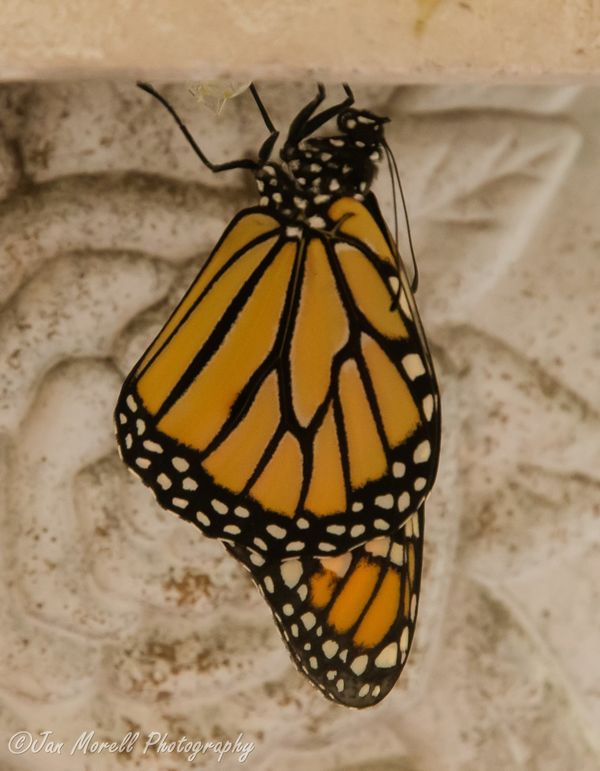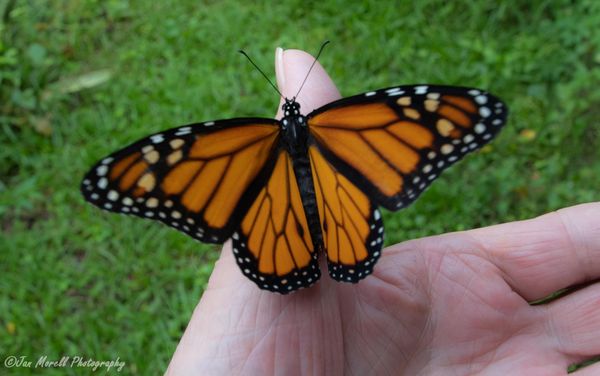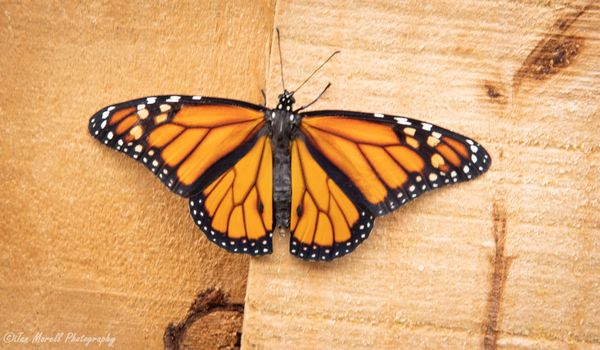My Monarch Adventure
Aug 2, 2019 11:29:47 #
I got interested in Monarch Butterflies last year, and wanted to do my part to help them survive. I didn't really get started in earnest until this year. I had cultivated some Milkweed plants and got my first cats about 3 weeks ago. I watched as they went through their stages of development, and happily realeased 10 this year. I still have one in JHook but the last Monarch emerged this morning.
The first image is one just after it emerged and hadn't dried it's wings yet. If you look closely, you can see the remains of her Chrysalis just above her.
The second image is from this morning. It is the first time I had handled one, and it is a Boy.
The third image is when he landed on the fence to finish drying his wings before he went out into the world to search for his mate.
It has been a lot of fun, and I will be much better prepared next year.
The first image is one just after it emerged and hadn't dried it's wings yet. If you look closely, you can see the remains of her Chrysalis just above her.
The second image is from this morning. It is the first time I had handled one, and it is a Boy.
The third image is when he landed on the fence to finish drying his wings before he went out into the world to search for his mate.
It has been a lot of fun, and I will be much better prepared next year.
Aug 2, 2019 11:37:13 #
As I don't know a lot about monarchs, How do you know it is a boy? I photographed one and am curious as to what sex it is. Thanks.
Aug 2, 2019 11:42:11 #
You can only tell if the wings are extended. Do you see the 2 brown dots on his wings close to the rear? Those are scent glands and only the males have them. Thanks for looking and commenting.
Aug 2, 2019 11:48:46 #
PaulBrit
Loc: Merlin, Southern Oregon
I don’t think we have Monarchs over here in Southern Oregon but I still love your photographs.
Aug 2, 2019 11:48:58 #
Aug 2, 2019 11:56:23 #
Aug 2, 2019 12:04:18 #
Very nice set. Thanks for that identification of a male. Nice to know what I’m shooting.
/George
/George
Aug 2, 2019 12:06:41 #
Aug 2, 2019 12:07:33 #
Aug 2, 2019 12:10:40 #
How long do they take to start emerging from the chrysalis? Trying to film one, been a week.
Aug 2, 2019 12:16:49 #
Jan, he's a beauty and you got very nice, detailed shots! I haven't had as many Monarchs so far this year. As a result you can hardly get around my garden because of all the head high milkweed plants!
Aug 2, 2019 12:18:18 #
PaulBrit wrote:
I don’t think we have Monarchs over here in Southern Oregon but I still love your photographs.
I don't know if you are on their migration path or not Paul, but thanks for your comment.
Aug 2, 2019 12:19:55 #
kenievans wrote:
Really nice shots Jan. Thanks for sharing.
Thank you Kenni. I appiciate your nice comment.
Aug 2, 2019 12:21:40 #
Fotoartist wrote:
How long do they take to start emerging from the chrysalis? Trying to film one, been a week.
For me it seemed to vary a little, but I would say in the neighborhood of 10 days to 2 weeks or so.
Aug 2, 2019 12:31:47 #
PaulBrit
Loc: Merlin, Southern Oregon
SpyderJan wrote:
I don't know if you are on their migration path or not Paul, but thanks for your comment.
Well I learnt something! From the USDA website:
Migration and Overwintering
The annual migration of North America’s monarch butterfly is a unique and amazing phenomenon. The monarch is the only butterfly known to make a two-way migration as birds do. Unlike other butterflies that can overwinter as larvae, pupae, or even as adults in some species, monarchs cannot survive the cold winters of northern climates. Using environmental cues, the monarchs know when it is time to travel south for the winter. Monarchs use a combination of air currents and thermals to travel long distances. Some fly as far as 3,000 miles to reach their winter home!
Where Do Monarchs Go?
Monarchs in Eastern North America have a second home in the Sierra Madre Mountains of Mexico. Monarchs in Western North America overwinter in California.
Eastern North American Population
Overwintering in Mexico
The eastern population of North America’s monarchs overwinters in the same 11 to 12 mountain areas in the States of Mexico and Michoacan from October to late March.
Monarchs roost for the winter in oyamel fir forests at an elevation of 2,400 to 3,600 meters (nearly 2 miles above sea level). The mountain hillsides of oyamel forest provide an ideal microclimate for the butterflies. Here temperatures range from 0 to 15 degrees Celsius. If the temperature is lower, the monarchs will be forced to use their fat reserves. The humidity in the oyamel forest assures the monarchs won’t dry out allowing them to conserve their energy.
If you want to reply, then register here. Registration is free and your account is created instantly, so you can post right away.









